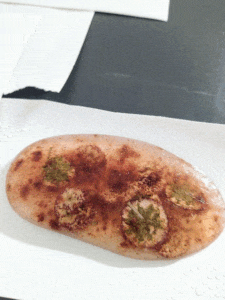6. BioFabricating Materials¶
It is the 6th week of Fabricademy and the 3rd class I am attending and the topic makes me thinking a lot about the Bootcamp in Geneva.
The beginning, research & inspiration¶
So the Bootcamp in Geneva is my so called starting point and also the first time I had practical experiences in doing bioplastic. I had previous contact with that topic but I never implemented it in my work. As it is a quite new method for me to work and also a new material I had to accept that I am not going to produce „the next level award winning bioplastic“ but I am going to understand the process and the material possibilities & properties. When I came back from Geneva I was fully inspired by the idea to reuse waste material from food and nature. In this case my nearest „nature source“ was the allotment. So from July on I started to collect everything suitable and available in bigger quantities from the garden like: poppy seeds, mullein seeds, onion seeds and dried onion flowers, different kind of petals and started to press flowers and different kind of plants in a self made flower press.
The Scoby¶
Before the 6th week started I was already in a rush to get at least two scobys for the bacterial fabric. So I asked in local groups for foodsharing on Telegram and WhatsApp if there is a left over Scoby. By the end I got two and I named them „George and Simone“. Both of them are waiting for their food and growing process. More content will follow soon.
Starting Point¶
In Geneva I made my first material out of gelatine and I really did not like the smell and idea of dead animals in my work. As I am vegetarian I don’t want to promote or at least use dead animal products in my work. Of course it is waste from the food industry and the Geneva-Sample made out of gelatine is interestingly hard and flexible at the same time - which is very nice to follow… BUT this time I did focus on plant based biomaterials:
Alginate
Agar Agar
Starch
Recipes¶
Alginate¶
I made four different recipes based on alginate to examine their properties when fully dry.
_Mix 1. supposed to be: medium elastic
400 ml reused dye bath from grinded tulip petals
8gr alginate
16gr glycerine
_Mix 2. supposed to be: elastic
1000 ml reused dye bath from yellow onion skins
20gr alginate
80 gr glycerin
_Mix 3. supposed to be: less elastic / less medium ??? experimental recipe
500ml reused dye bath from red onion skins with acid
500ml water
20gr alginate
20gr glycerine
_Mix 4. supposed to be: flexible bio sheet
800 ml water
24 gr alginate
80gr glycerine
Fillers I used in the order of experimentation:
0 - plain
1 - residue from a broom manufacturer: animal hair/bristles
2 - poppy & mullein seed mix
3 - onion petals
4 - crushed tulip petals
5 - pigments from class #4 mixed with poppy seeds
In total I have 24 small samples to compare with. I used plastic cups and the bottom of the cups has a diameter of ca. 5 cm. The height of the liquid was +/- 0,5cm.
Afterwards I had enough left over alginate-mix to proceed with an experimental approach and put the liquids directly on plastic sheets and let them dry. I made very thick layers and this turned out to be a „mistake“ as I found out…I combined:
- Mix 1 & 2 with the waste of the tulip dye in the form of grinded tulip petals
- Mix 3 combined with animal hair/bristles and dried flower leftovers
- Mix 3 with a mix from my dried and pressed flowers
- Mix 1 & 2 with dried tulip petals and other dried and pressed petals
- Mix 2 with dried flowers and poppy seeds

Fully dried results¶

I made one Agar Agar sample with the following recipe:
- Agar Agar:
- 200 ml of reused dye bath from yellow onion skins 4gr Agar Agar powder 12gr glycerine
I suppose I had issues with my electric scale as I was not able to measure correctly the amount of Agar Agar and it might be that I used more than 4gr. The Agar Agar surface was also the first sample that was "dry" enough to take off the foil. But it was also at the same the only sample that was full with mold - probably because of the fillers (dried plant material)
- tapioca starch:
- 250ml reused dye bath from red onion skins with acid 25gr tapioca starch 10ml glycerine 10ml vinegar
everything went smooth so far and it is the only sample that seems to be safe from molding and is not shrinking in the diameter.
Observations during the drying process¶
I made definitely too thick layers and the drying process takes a long time. All samples with fillers from plant materials began to mold so I had do clean them with vinegar. I hope this will help to get rid of the fungus.I am still waiting for the samples to fully dry and being able to examine them.